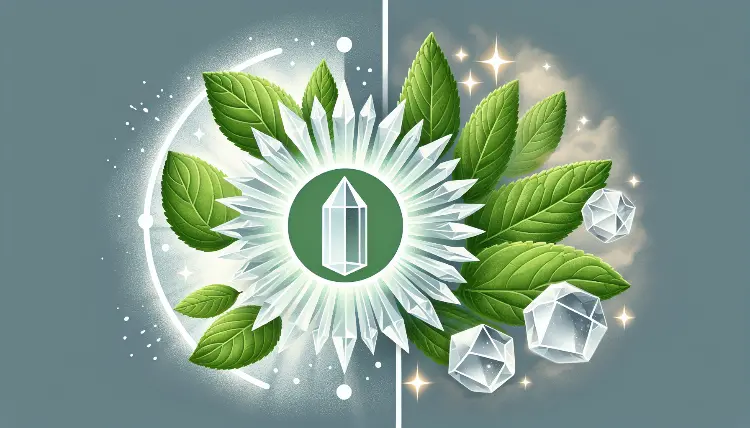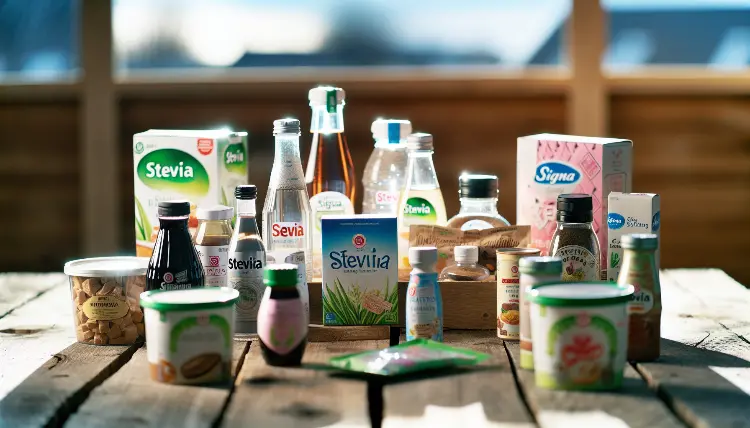Stevia, a natural sweetener coveted for its zero-calorie sweetness, has been embroiled in a whirlwind of controversy in Europe. But what led to the ban of this South American plant, and why was stevia banned in Europe still a bone of contention among regulators and industry leaders? Let’s unravel the layers of this complex narrative.
Artificial sweeteners like Sweet’nLow, Equal, Splenda, and others are known for causing gastrointestinal issues and reactions in people sensitive to the ingredients. Some people enjoy the taste of artificial sweeteners while others can’t drink diet soda because of its strong “fake sugar” flavor. Stevia came on the market as a natural alternative to both sugar and artificial sweeteners. It is well-known that certain artificial sweeteners contain ingredients that are carcinogenic. The warning label appears on boxes.
However, the United States has a long history of not banning products that are proven to cause cancer and other major health issues. Why? Money. Cigarettes are a great example of this. The tobacco industry is too powerful and lucrative. Being that stevia was touted as a natural alternative to sugar, it was surprising to hear that the product had been banned in Europe.
Key Takeaways from this article
✔️The European ban on stevia was initially motivated by potential cancer risks and safety concerns,although the influence of the food industry may have played a role.
✔️Purified stevia extracts are approved for consumption due to their safety and clean taste, while whole leaf stevia and crude extracts remain prohibited.
✔️Stevia products are available in various forms throughout Europe with growing consumer awareness. Health benefits should be weighed against potential risks before use.
The Stevia Dilemma: Understanding the European Ban

The controversy surrounding stevia largely stemmed from initial safety concerns. Studies suggested potential cancer risks associated with its consumption, which led to a ban in Europe. Despite its acceptance and long-standing usage in countries like Japan and Brazil, Europe opted for caution. Nonetheless, the European Union changed its stance in 2011, approving high-purity steviol glycosides as food ingredients.
Adding complexity to the narrative was the considerable influence of the food industry. Suspected financial motivations, such as competition with existing sweeteners, were thought to be behind the ban. The industry’s lobbying efforts also resulted in the approval of sweeteners, which could potentially be carcinogenic, while concurrently banning natural stevia. Nevertheless, regulatory requirements and safety concerns were the primary drivers of the initial prohibition.
The Initial Safety Concerns
The initial concerns about stevia’s safety were rooted in early studies suggesting its potential to cause cancer. (Doesn’t everything cause cancer nowadays?) These findings led the Food and Drug Administration (FDA) to classify stevia as an ‘unsafe food additive,’ prohibiting its use as a sweetener in the United States. However, the speculation of financial motivations from the sugar industry adds a layer of complexity to the issue. Could the sugar industry’s potential fear of losing market share to stevia have influenced the ban? It’s very likely to be a factor.
The initial prohibition of stevia put a damper on the enthusiasm for this natural, zero-calorie sweetener. However, as research evolved, so did the regulatory perspective, leading to a shift in the classification of stevia by the FDA from an ‘unsafe food additive’ to being ‘generally recognized as safe’ (GRAS).
The same way you’ll see articles about eggs being good for you, then a few years later: “Scientists have now determined that eggs are unhealthy and fattening.” A few years later: “New findings show eggs are very good for you!” A lot of people had been excited to see a sweetener on the market that came from natural sources vs. the carcinogenic chemicals found in the popular artificial sweeteners currently on the market.
The Food Industry’s Influence

The food industry’s potential financial motivations for prohibiting Stevia could have stemmed from a desire to maintain the dominance of existing sweeteners and safeguard their profits. This is evident in the approval of potentially carcinogenic sweeteners such as saccharin, aspartame, and sucralose, while simultaneously having stevia banned.
The same financial motives can be found in the pharmaceutical industry in the U.S.. There are highly effective drugs available to treat depression, but the United States is the only country that hasn’t approved the drugs for use. If you look at the current stranglehold that some brands of antidepressants have on the market, it’s not hard to see why introducing a new medication that patients have claimed “cured” their depression would be very bad for the manufacturers of Prozac and other commonly prescribed antidepressants.
Stevia’s Journey Through Legislation
Stevia’s journey through the complex realm of food legislation has been a tumultuous one. Before its reclassification, it did not receive initial approval for processing into products in the EU. The plant and leaves were only allowed in specific applications. The reclassification of stevia as a non-novel food has enabled marketing infusions made from stevia leaves in the EU, contributing to improved clarity and transparency in labeling and usage. The main challenge for stevia in obtaining EU approval was securing permission for its processing into products, initially facing restrictions on the plant and leaves themselves.
The Food Standards Agency and Stevia
The Food Standards Agency (FSA) considerably influenced stevia’s prohibition in Europe. It initially banned stevia due to concerns about its safety and potential cancer connections. This decision was in line with the broader European response to the potential health risks associated with stevia. However, as more research emerged, the FSA revised its stance on stevia, acknowledging the potential health benefits and the safety of high-purity steviol glycosides.
The Current Status of Stevia in the EU

Purified Stevia Extracts vs. Whole Leaf Stevia
Purified stevia extracts are considered safe for consumption due to their extensive purification process and approval by regulatory bodies such as the FDA. These extracts eliminate the majority of the bitter components, providing a clean, sweet taste that has made them popular in the food and beverage industry.
On the other hand, whole leaf stevia and crude extracts are not approved due to safety concerns. The absence of toxicological information and research on their safety has led regulatory agencies to decline their use as food ingredients.
Acceptable Daily Intake and Usage Guidelines
The acceptable daily intake for steviol is 4 mg/kg of body weight, equivalent to 12 mg/kg of high-purity stevia extract per day. This recommendation is based on over 200 studies that have shown stevia to be safe for consumption within this limit, as determined by the Joint FAO/WHO Expert Committee on Food Additives (JECFA). For example, an individual weighing 70 kilograms should limit their daily consumption of high-purity stevia extract to 280 milligrams.
These guidelines provide a safety net for consumers, ensuring they can enjoy the sweetness of stevia without exposing themselves to potential health risks. However, individuals with preexisting health conditions should consult a healthcare professional before incorporating stevia into their diet.
Health and Consumption: Evaluating Stevia’s Impact
The health implications of consuming stevia are as complex as its regulatory journey. Stevia is considered safe for consumption and is believed to offer various health benefits, such as the potential to reduce total daily calorie intake and sugar consumption. Its use has demonstrated no insulin or blood glucose response, and it may even contribute to lowering blood pressure. However, certain individuals may experience side effects like nausea, abdominal fullness, muscle pain, and weakness following the consumption of stevia.
While the potential health benefits of stevia are compelling, it’s important to weigh them against potential health risks. Despite copious research, the overall impact of zero-calorie sweeteners like stevia on the body remains unclear. More research is needed, particularly regarding the consumption of stevia by pregnant women and its long-term effects.
Potential Health Benefits of Stevia
Stevia’s potential health benefits extend beyond its sweetness. For individuals with diabetes, stevia can be a game-changer. As a natural sweetener with no calories or carbohydrates, stevia exerts minimal impact on blood sugar levels. Additionally, it has the potential to assist in weight management and reducing appetite, which are significant factors for diabetic patients.
Beyond diabetes management, stevia could potentially aid in:
- Weight loss due to its minimal calorie content
- Reducing blood pressure in individuals with hypertension
- Providing antioxidant activity, contributing to its potential health-promoting properties.
Addressing the Health Concerns
Despite the potential health benefits, some concerns surround the consumption of stevia. These concerns include:
- Elevated risk of type 2 diabetes
- Cardiovascular diseases
- Nonalcoholic fatty liver disease
- Potential behavioral and cognitive issues
- Migraines
- Carcinogenic effects
However, a thorough review of 372 studies concluded that short-term use of stevia did not result in an elevated risk of cancer, suggesting that stevia may possess anti-cancer properties. Despite these promising findings, the potential long-term effects of stevia consumption on the body are still not fully understood. Therefore, individuals with preexisting health conditions should consult a healthcare professional before incorporating stevia into their diet.
Stevia in the European Market: Availability and Products

Despite facing controversy and regulatory hurdles, stevia has found a place in the European market. Consumers can find stevia in a variety of forms including liquid, powder, and granules, often mixed with other components. The primary distribution channels for stevia products in Europe involve importers and distributors who supply them directly to food and beverage processors and manufacturers. Furthermore, the market for stevia in the European food and beverage industry can be segmented by application, offering a range of opportunities for incorporation into different products.
The growing consumer awareness and acceptance of stevia-sweetened products in Europe suggest that consumers have embraced them despite previous concerns about potential health effects. The competition in the European market for stevia extract and leaves comes from within the EU, specifically France and Spain, and notable non-EU exporting countries like China, Morocco, India, and Malaysia. The regulations impacting stevia products in Europe require adherence to EU legislation and buyer-specific requirements.
Expect Health Food Stores to Stock Stevia
Health food stores across the EU have embraced stevia, recognizing its potential benefits as a natural sweetener and food ingredient. Stevia-based products, including stevia extract powder, table-top sweeteners based on steviol glycosides in liquid or tablet form, and zero-calorie sugar substitutes, are commonly available. The rising demand for natural and healthier products, market segmentation by industry, and the various functionalities of stevia as an antioxidant, antidiabetic, anti-inflammatory, and antimicrobial, influence the availability of stevia products in these stores.
When marketing stevia products, these stores emphasize:
- the clean, sweet, and sugar-like taste
- its natural and label-friendly attributes
- benefits like strong market availability and positive consumer perception
Indeed, stevia has not only carved a place for itself in the European market but has also become a staple in health food stores.
Food and Beverage Manufacturers Incorporating Stevia
The food and beverage industry has also hopped on the stevia bandwagon. Manufacturers like PureCircle by Ingredion have received authorization from the EU Commission for their steviol glycosides produced via bioconversion. The high solubility of these extracts has made them attractive to European buyers, suggesting a potential for increased adoption of stevia in European products. Stevia is commonly incorporated into a range of products, including:
- bakery items
- dairy food products
- beverages
- dietary supplements
- confectionery
The manufacturers promote stevia-sweetened products by emphasizing their natural credentials, and benefits like strong market availability and positive consumer perception. The consumer response to stevia-sweetened products in Europe has been predominantly favorable, characterized by growing consumer awareness and a rising prevalence of food and beverage items containing stevia.
Stevia’s journey through the European regulatory landscape has been a roller coaster of bans, concerns, revisions, and acceptance. Its potential health benefits and the increasing demand for natural, low-calorie sweeteners have carved a niche for stevia in the European market. Despite the controversy and the availability of alternatives, it seems that stevia has secured its place as a popular choice for those seeking a natural sweetener. However, the evolving research and regulatory stances remind us that the world of sweeteners is as complex as it is sweet, necessitating informed choices for the benefit of our health.




